With recent changes to Amazon FBA fees, you may be wondering what spring has in store for you and other FBA sellers. Here’s a breakdown of your costs and fees.
We ran through Amazon selling fees in a recent post. We were very pleased that you, our readers, reached out to us with comments and questions. We’d now like to go over the fees you’d be charged when selling your orders via FBA (that’s seller lingo for AFN- Amazon Fulfillment Network).
How Much Does FBA Cost?
Amazon uses various criteria to charge FBA sellers, like the type of item, the size and the selling price. Products selling for more than $300, for instance, don’t incur any fulfillment fees, but all others do.
There are some Amazon fees that apply to all merchants, as shown in the table below.
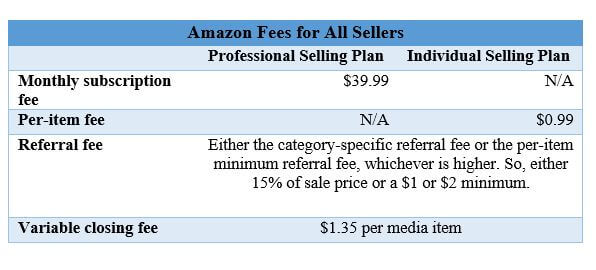
Aside from these, there are some FBA-only fees. Here’s a breakdown of these Amazon FBA seller fees:
- Fulfillment Fees
As mentioned in a recent news post, these costs are no longer broken down in your statements into pick & pack and weight handling fees. They’re now charged as a single, per-unit Fulfillment Fee A flat fee charged by Amazon for … More. To view your estimated fulfillment fees, please read this page.
- Storage fees
These are levied monthly, depending on the space your item takes up at the fulfillment center, in cubic feet. They vary by type of item and by time of year.
Items that have been stored at a fulfillment center for more than 6 months incur a Long-Term Storage Fee of $11.25 per cubic foot. Fees charged for items stored longer than 12 months are twice as high.
FBA-only fees (points 3 and 4 above) are no longer different for media and non-media items. Standard Size Items will be charged for domestic and international orders as seen below:
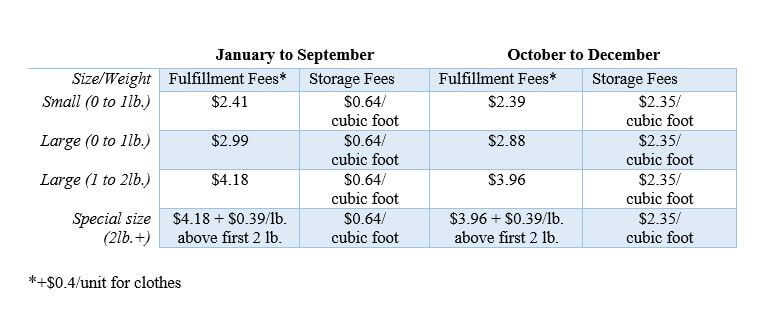
For domestic orders, oversize items are charged as below:

To view your storage fee estimates, use Amazon’s storage fee calculator.
Note: Amazon FBA fees will vary depending on the platform (Amazon.com versus your own website, for instance). VAT or Tax may apply in some states or countries. Using the FBA Revenue Calculator (sign-in necessary) is a good way to estimate these fees if you’re a US-based seller (so VAT does not apply to you). For multi-channel fulfillment, a dedicated help page is available here.
I personally recommend using the free FBA Calculator for Amazon browser extension to check all your Amazon FBA fees, as well as monthly sales and revenue estimates across all venues.
So What’s Changed?
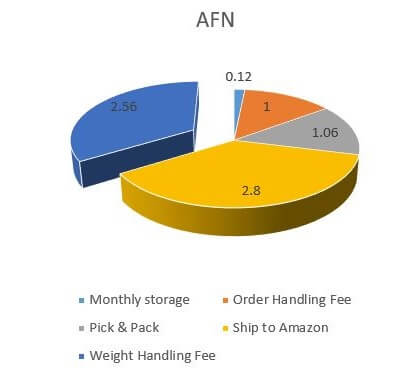
The pie chart above shows you an estimate of Amazon FBA fees and shipping costs for ASIN B01CNSO79Q, as they would have been at the beginning of the year. But AFN charges are no longer broken down as above. This year, fulfillment fees (weight handling + pick & pack + order handling) will be billed together.
Secondly, fulfillment fees will be lower and storage fees will be higher. That means you need to be more prudent when you send items to Amazon. Now more than ever you need to make realistic storage and sales forecasts.
How FBA Weights are Calculated on Amazon
Before you send your products to a fulfillment center, double-check the outbound weight. Amazon may charge you more than what you’d expect in fulfillment fees. That’s because they add the weight of their packaging to the shipping weight calculation, for one thing.
Secondly, you may be charged based on the concept of dimensional weight or volumetric weight. It’s an estimated value that allows them to levy more in Amazon FBA fees for light but bulky products that take up a lot of space.

So, for large and oversize products, you’ll be charged for either the dimensional or the unit weight – whichever is greater. The dimensional weight is calculated in pounds by Amazon as: (length x width x height in inches)/166. The unit weight is the weight displayed on your scale.
How to Estimate Your FBA Profits
To calculate your profit estimate, use the FBA Revenue Calculator. Ultimately, you’ll need to decide whether to use MFN or FBA fulfillment based on this estimate. Comparing MFN and FBA profits usually comes down to fulfillment and storage costs (the bottom half of your profit report). That’s because Selling on Amazon fees (referral, variable and per-item fees) are the same, as seen below:
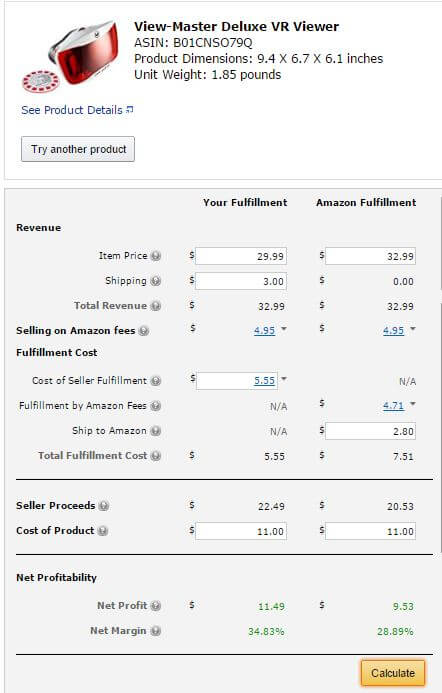
Note: We used the same selling price here (shipping charge included) and the same ship-to cost for both MFN and AFN fulfillment. In reality, sending more than one unit per shipment to an Amazon fulfillment centerWarehouse and distribution center owned … More may cost you less than sending one unit at a time to your MFN customers. However, you need to make sure that the product sells quickly, before monthly and long-term storage fees offset those small savings.
So How Much More Does Selling on FBA Cost Me Now?
This will depend on the number of units you send to Amazon, how much it costs for you to ship them to a fulfillment center, their weight and how quickly they sell. To make it easier for us to visualize the change in fulfillment and storage fees, we’ll exclude fixed and universal fees (Fig. 1) from our calculations.
- Scenario 1
Our reference product is ASIN B01CNSO79Q, the one in figures 4 and 6. Let’s assume that it costs $2.8 to ship to Amazon, you’ve paid your distributor $11 for it, and you sell it in the first month for $32.99. Here’s a cost comparison:

So, you’d save $0.03 selling it now.
- Scenario 2
Another product, ASIN B00F5E43E0, costs $5 to ship to Amazon. You’ve paid your distributor $50 for it, and you sell it in the first month for $159.51. Here’s what your total FBA costs would look like:
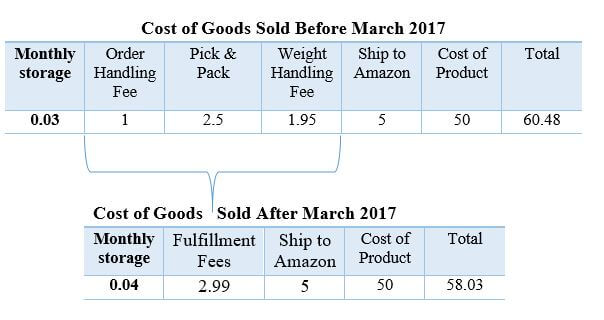
So, you’d earn an extra $2.45 selling it now.
Note: These calculations are estimated based on the given weight and dimensions for these products. Actual costs may vary.
How About Long-Term Storage Fees?
What happens if you were to sell these 2 products several months from now on FBA? Let’s use the Amazon Inventory Storage Calculator to see what extra storage fees you would pay until then.
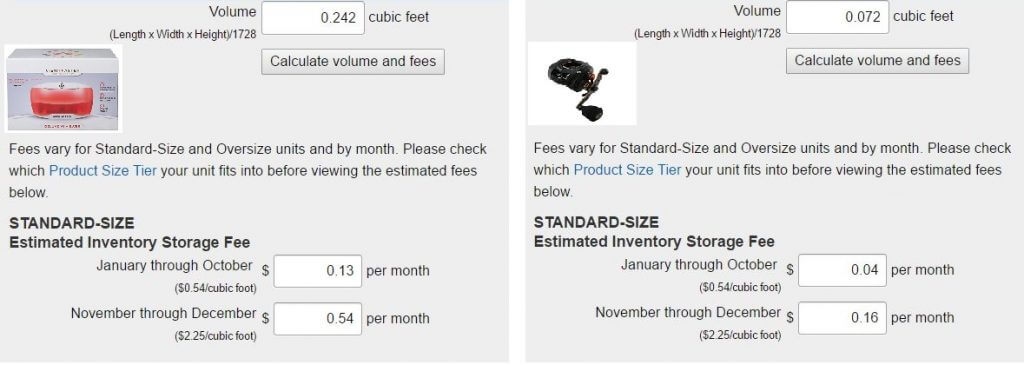
The first product, ASIN B01CNSO79Q, has an estimated volume of 0.242 cubic feet per unit. You’d spend $0.13 per month until September. From then on, it’s $2.72 ($11.25/0.242 cubic feet) per unit on long-term storage fees, every month for the next sixth months. Then the fees would double, at least.
The second product, ASIN B00F5E43E0, has an estimated volume of 0.072 cubic feet per unit. You’d spend 4 cents per month from now until September. From then on, you’d pay long-term storage fees of 81 cents per month ($11.25/0.072 cubic feet) for the next 6 months. From then on, it’s twice as much, if fees stay the same.
Assuming you sell both these products in 9 months, you’d pay an extra $8.49 and $2.67, respectively, per unit, in storage fees. In other words, the much cheaper but bulkier product would cost you more than 3 times what it costs to store the second one. Also, it wouldn’t be profitable for you to store the first product on FBA any longer.
This concludes our Amazon FBA fees analysis. Please share your comments and and experiences with the Amazon FBA process.
Melanie takes an active interest in all things Amazon. She keeps an eye on the latest developments, and keeps Amazon sellers up to speed.

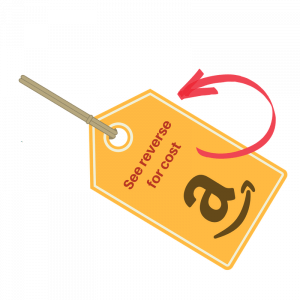






9 Responses
Great stuff. Very informative. Thank you?
“Products selling for more than $300, for instance, don’t incur any fulfillment fees, but all others do.” You mind explaining?
Hello,
Thank you for following our blog. I am happy to hear that you find our articles useful.
To answer your question, when doing FBA, Amazon takes into consideration various criteria to calculate the fees that they incur for anything that’s related to their help with manipulating the items, size of items or price. So far the items that were price over $300 did not incur any fulfillment fees. However, Amazon announced that this will be discontinued and that the incurring fees will be the following.
I hope this helps.
Let us know anytime you have questions.
Thank you,
Julia
SellerEngine Team
Hi
I am Ales from Slovenia (EU country) and planning to sell (Pro Merchant) filament for 3D printers on Amazon.de. The estimated price per item will be 20 € (19% German VAT included; price without VAT will be 16,80 €) and gross weight 1300 grams.
I would like to ask you to help me with following calculation.
I) Amazon full service (product in Amazon internet shop, stored at Amazon and delivered by Amazon)
a) Sells to natural persons
(1) Price per item in internet shop: 20 € (VAT included)
(2) Delivery costs: 2,5 € (estimation)
(3) Buyer pays: 22,5 €
My obligations
i) Monthly subscription (app. 40 €)
ii) Storage fee (how do I calculate it?)
iii) Referral fee
How high the fee is for filament for 3d printers?
What is the base for calculation of referral fee? (1) or (3)?
iv) Order handling (how do I calculate it?)
v) Pick and Pack (how do I calculate it?)
vi) Weight handling (how do I calculate it?)
vii) Are there also other expenses/fees?
b) Sells to legal persons
(1) Price per item in internet shop: 16,80 € (VAT not included)
(2) Delivery costs: 2,5 € (estimation)
(3) Buyer pays: 19,30 €
Is in such case referral fee based on price with or without VAT?
II) Amazon internet shop only (product in Amazon internet shop, stored at my place and delivered by me)
Which off my obligations (described above) need to be considered here?
I am thanking you in anticipation and looking forward to your answer.
Best regards,
Ales
Dear Ales,
Thank you for following our blog and submitting your questions.
The fastest reply to all your questions is the Amazon fee calculator that automatically calculates for you all the necessary fees and commissions.
It is easy to use: you just need to put in the name of the product/the ASIN or ISBN and your sell price.
Please note that the Amazon fees calculator does not take into consideration the the VAT.
Please check it out and let me know if it was helpful to get an answer to your questions. If not I’ll most definitely address what is still unclear.
Thank you,
Julia
SellerEngine Team
hi
i want to know how to calculate Estimated monthly sale of product and fixed closing fee.
please explain how fba calculate these attribute
thanks
Hello amit mehra!
Thank you for your interest in our blog.
When a customer makes a purchase Amazon takes the shipping fee at the time of the sale. A ‘Variable Closing Fee’ is deducted from the shipping fee before Amazon passes the rest onto you as postage credit (i.e. the money you use to pay for the actual posting of the item). The VCF applies to all media products (books, music, video, blu-ray & DVDs).
If you are using FBA you will still need to pay a VCF on media products. However you do not receive postage credit from the sale as you are not posting the item yourself. To check Amazon UK variable closing fees, please check the link below:
https://services.Amazon.co.uk/services/sell-online/pricing.html#soa-sell-little
Amazon doesn’t disclose sales data. What you can do is to estimate sales by looking at other publicly accessible data such as:
1. Number of items in stock: this is very simple. You check the number of items in stock at a certain time, then after, say, 24 hours, you check again and then you can see how many items were sold. You can check everyday for like one week to have a better estimate and average.
2. Best Sellers Rank: there are some tools that try to estimate number of sales by looking at the Best Sellers Rank. They use the same method as number 1, they track items in stock for a few different products and also associate that with the BSR, then you can estimate other products sales just by looking at the BSR.
Thank you,
Roxana SellerEngine Team
Hello, my name is Patricia Knight, and I am interested in the FBA Amazon Program to sell used books. I understand that Amazon has a neat program that essentially allows you to dump old books, movies gadgets and more in a box–send to Amazon and wait for the money to roll in? Are things that simple?
You basically dump your things, in my case “books” in a box, tell Amazon whats inside of that box, print out a shipping label and schedule a pickup request? I’m told the process generally takes an hour or two, unless you have more stuff than you could ever possibly sell. Did I miss anything? My question is…. how do I know how much Amazon will pay me for my books–since I don’t get to set the price? Where can I
go on the internet to learn how to sell on Amazon? There is so much information on the internet and everyone is saying something different. So , I turn to you before I get started. Thanks for all your help!
Warm regards,
Patricia Knight
Hi Patricia,
Well I’ve got good news and bad news. The good news is that Amazon is a great platform for selling used books and movies, but the bad news is that it’s not quite as easy as you’d hoped. I’d be happy to give you a call to go over the basics of setting up an FBA selling account. Please send me an email at services@SellerEngine.com and we can set up a time to chat over the phone and get your business going.
Thanks for this article. It is very informative. Since changes are constant even on Amazon, it is important to analyze the breakdown of costs and fees. To make this task easier, you can use an Amazon FBA Calculator for that: https://sellerseo.com/acosinator-3.